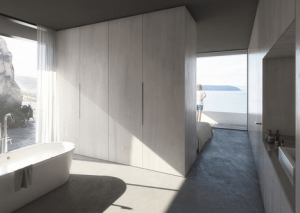Standard cavity walls are typically 300mm thick with a 100mm cavity. However, there can be some huge benefits if you increase wall cavities to 150mm. We want to have a closer look at this today. Then, if you want some help with residential architecture in London, you can speak to us.
Increasing standards
 An important thing with housing is the drive to make it more energy efficient. We can already see this in things like the 2022 Approved Document L building regulation for England. The Future Homes Standard is to come as well, ensuring a reduction of the operation carbon of all new homes. They will need to produce 75% less carbon than homes built to standards from 2013.
An important thing with housing is the drive to make it more energy efficient. We can already see this in things like the 2022 Approved Document L building regulation for England. The Future Homes Standard is to come as well, ensuring a reduction of the operation carbon of all new homes. They will need to produce 75% less carbon than homes built to standards from 2013.
Wider cavities are really useful here. They give people a chance to use a broader range of insulating materials. As a result, they can improve the thermal performance of walls.
A problem with narrower wall cavities is it means there is less space for insulation. Therefore, people tend to use rigid boards. While they can be effective, there are problems. It is difficult to install. If it isn’t flush or isn’t taped properly, it can leave gaps. Just a couple of millimetres can massively increase heat transfer, meaning the property may not be as energy efficient as it should be.
If you increase the size of the wall cavity, you can use mineral wool instead. It is much easier to install and, because of the nature of the material, it can knit together to ensure there are no gaps. So, it can ensure excellent thermal performance.
Fire safety
Whether it is residential architecture in London or other types of property elsewhere in the UK, there is a bigger focus on fire safety. Approved Document B was also updated in 2022 to restrict the use of combustible materials in buildings in England. The London Plan has gotten stricter too, requiring the creation of a Fire Statement to confirm external walls don’t include them.
Increasing the cavity wall thickness to 150mm is helpful here. It means you can use thicker, non-combustible materials. Again mineral wool is a really good option.
Avoid supply chain problems
Finally, increasing wall cavities to 150mm can actually help to reduce the risk of encountering supply issues. The last few years have been tough for the construction industry because of material and labour shortages. Some projects are still on hold. If you have a larger cavity, it massively increases the range of products to choose from. As a result, if there is a shortage of one, an alternative can be chosen easily.
Do you want help with residential architecture in London?
If your goal is to create more sustainable homes, it is a good idea to look at the size of cavity walls and the type of products you are using. You can even specify lower carbon materials to ensure a smaller impact on the environment.
The best thing to do is talk to architects. They can look at different options for all parts of properties. We’d be happy to help, and have a wealth of experience when it comes to designing with sustainability in mind. You can explore different design, materials, layouts, and more to get the best results.
So, if you want to work with us to create stunning residential architecture in London, please get in touch. We’re ready for any challenge and can help you to overcome them.
